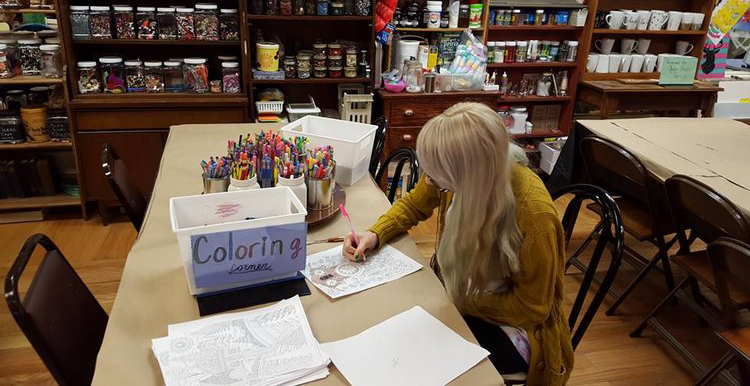
Through her years working as a foster mother, Carol Andersen encountered numerous women from marginalized communities. There were domestic violence, sexual assault, and human trafficking survivors, including mothers fighting not only to get their kids back but to get their lives back as well.
“These families were really torn apart by violence,” Andersen said. “As I learned about their challenges it led me to fund solutions that could help them rebuild their lives, reconnect with their children, and kind of put their family back together.”
Under the 501c3 organization called Connections for Women, Andersen developed Bloom Creative Studio and Bloom House. Bloom House is an eight bedroom living facility for women with addiction and trauma survivors. The creative studio is a drop-in workspace and gift shop that features handmade soaps, candles, jewelry, pillows, wooden items, and more created by the women. Along with helping survivors create art and learn new skills such as woodworking, the studio also provides the women of Bloom with economic opportunities and job experience by employing them.
“It’s a great way for [the women] to give back to their community and to meet people and network,” Andersen said, “as well as to begin earning money as they rebuild their lives.”
Getting its start
The idea of Bloom Creative Studio came from a program in Nashville, Tennessee. In 1997, the program started a five-bedroom residence and developed 50 sister models across the nation.
After several years of working with sex trafficking survivors, the organization learned that unless they helped the women gain economic skills and resources, they could never truly learn how to live on their own.
From there, they opened up their own bath & body care company and a café, which gave the women economic and job opportunities as well as increasing their personal skills. The idea became so popular that all 50 of the sister organizations adopted the model.
Carol heard about the business model at a conference in Nashville back in 2014. The host talked about all the business enterprises the sister organizations had opened such as t-shirt companies, selling handmade items like soaps, and of course cafes. However, she felt that those businesses weren’t a right fit for her town.
“We already have a lot of cafes in our area,” Andersen said. “We wanted to do something kind of unique and unusual and we felt [an art studio] would be a good way for us to give back to our community which was something really special.”
An opportunity for healing
The studio isn’t only a business venture. It allows survivors to create art in a place where they can feel safe.
“[Art] allows you to process negative feelings, memories, and emotions, and all three create something that can be beautiful as a result of that, that has color and texture,” she said. “Using different mediums can help you process emotions that you may not have been able to experience because they were too painful.”
Alongside Bloom, Andersen works as a grant writer and survivor advocate at a domestic violence agency in Monroe County and works closely with other women’s resource centers. For the women who did not have custody of their children, the number of treatment options drops dramatically, Andersen said. So, she set out to create a program for women who did not have their children.
“While some people look at that and say ‘why aren’t you helping women and their kids?’ it really is a unique opportunity for them,” she said. “ It really is a great opportunity for them to really focus on themselves and heal and start over while rebuilding that relationship with their children while they live in our program.”
The journey towards resilience
For four years, Andersen has given survivors a platform to help rebuild their lives and start healing through art. Still, she says the programs are growing. In the years to come, she hopes they will have enough funding for full-time staff, in the residence and the studio.
Her journey has taught her more about the lives of women from marginalized communities and the meaning of resilience.
According to Andersen, the studio has helped build relationships in the community and among the women and allowed them to start to rebuild their life
“Resilience can come in many different forms and can often be unseen at first but it really builds slowly,” she said. “If you trust the process and move through it I believe healing will come, but it’s often not in the way we planned.”
Learn more about Bloom Creative Studio, including how you can support their work at www.bloombangor.org
